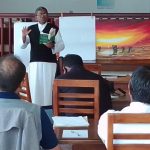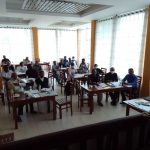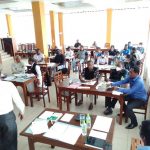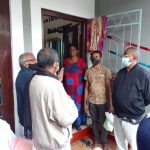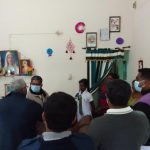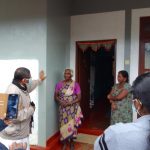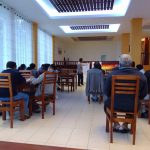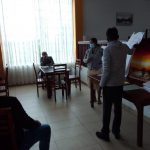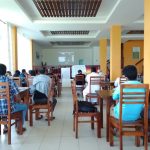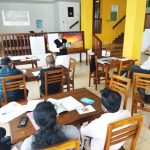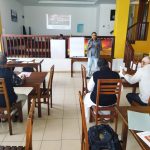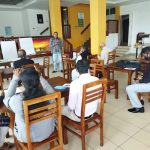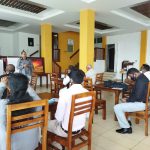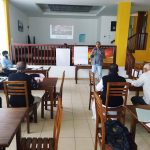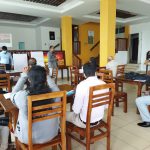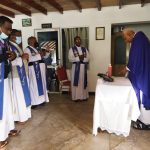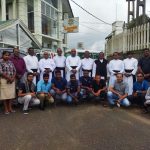A 2-day pre-orientation programme was held in Mahagastota, Nuwaraeliya on 29 and 30 November 2021 under the new programme designed for the empowerment of the tea plantation communities in Sri Lanka.
The programme comes with a 10-year vision and is titled, “Lighting the Lives” – Empowering the Green Gold Harvesters, which is an extension of the Caritas Green Gold Harvesters project implemented in the Dioceses of Badulla, Galle, Kandy and Rathnapura for the welfare of the tea plantation communities.
The newest intervention will be implemented in 5 Dioceses including Colombo other than the previous locations as a sizeable segment of the tea plantation community is living in the western province towards Kaluthara and Mathugama.
Addressing the participants, Fr, Mahendra Gunatilleke, National Director of Caritas Sri Lanka stated, “It is high time that they come out of their miseries and live a life with dignity, especially at a time they mark 200 years of their arrival to Sri Lanka.”
Mr. Mylvaganam Thilakarajah, former Member of Parliament from Nuwara Eliya District who is also a zealous advocate and an activist for the welfare of the Indian Origin Tea Plantation People joined in as the resource person on the first day of the sessions.
He elaborated how this community has been completely neglected by the governance structure in the country and how it has adversely affected their lives now and for the generations to come. He urged the participants to think through the structural discrimination that this community has gone through for over 200 years of their arrival to Sri Lanka in the 1820s and to join in hands to identify the strategic interventions, this project could bring in as solutions to give them a life with dignity as other Sri Lankans.
The Diocesan Directors and programme coordinators of Colombo, Badulla, Galle, Kandy and Rathnapura and the Caritas National Centre staff participated in the 2-day study session.
They also took part in an exposure visit some houses built for this community at St. Clare’s Colony, Talawakelle in Nuwara Eliya under an electricity project funded by the Japanese government. However, the house owners were lamenting that they have lost their former income generation activities in addition to losing the communal spirit, which they enjoyed while they were living in ‘line-rooms’ – linearly attached houses. They said that unlike earlier when a death occurred in their neighbourhood, no one would come to know about it, until they bring the body out for burial.
The second day was dedicated to comprehend the Catholic Social Concern for the Poor and Vulnerable with a special focus on the agonies of the tea plantation people in Sri Lanka. Rev. Fr. Micheal Rajendram delivered a presentation on the above theme and invited all the Diocesan Directors and the Programme Coordinators to embrace this intervention as a mission rather than a time-bound project activity. For the past several decades, Fr. Rajendram has worked tirelessly for the emancipation of the tea plantation community.
The newest interventions focusing on the liberation of the tea plantation workers will be funded by the Catholic Relief Services (CRS), an organization that has implemented projects previously for the welfare of the tea plantation workers in the Diocese of Kandy.
Facts related to the Indian Origin Tea Plantation Community
- The population of this community consists of 4.4% in Sri Lanka (Department of Census and Statistics – DCS, 2012)
- After long decades of struggle, by 2009, the Estate Tamil community completely obtained Citizenship.
- The Poverty Head Count Index (PHCI) of Estate sector 8.8% compared to Rural (4.3%), urban (1.9%) and the national average of 4.1% (CBSL, 2019).
- The average monthly income of estate households is Rs. Rs.34, 804, which is lower than the Urban (Rs.88, 692,), Rural (Rs.58, 137) and national average of Rs. 62,237 in 2016 (DCS, 2016).
- It is noted, when the nominal household income per month in Sri Lanka is reported as LKR 43, 511 in 2018, in the Estate sector as LKR 29,134. The Estate sector households are among the poorest 40 percent households of the country in 2016 (DCS, 2018).
- The Poor Household Percentage indicates as 6.8% in the Estate sector while urban and rural are 1.3% and 3.3% respectively (DCS, 2018).
- The Poverty Gap Index also reflects that the Estate sector is high (1.2%) while comparing with Urban (0.3%) and rural (0.6) (DCS, 2016).
- According to the Plantation Schools Unit of the Ministry of Education, there are 843 Schools have been listed as Estate Schools under a separate UNIT called Plantation School Unit (PSU).
- The literacy rate in the Estate sector is reported at 82.7% when the national level is reported as 92.9%, rural level 92.9% and Urban 95.7% (DCS, 2019).
- Percentage of Households with the improved source of drinking water by residence is recorded 90% in National, 99% in Urban, and 91 % in rural but only 43% in the Estate sector, 57% of them are using non-improved sources and 4% does not have proper sanitation facilities in the Estate sector (DCS, 2016).There are 40% of the estate population have no proper toilet facilities.
- The average Under-five mortality rate has been recorded in urban 11, rural 12 deaths per 1,000 live births, but in 15 deaths estate sector (DCS, 2016)
- Apart from garments, rubber, and spices — tea brings roughly $1.3 billion a year into the country.
- 320,000 people are employed in the Plantation sector while the number of dependents extends to over a million people. ( Plantation Human Development Trust- PHDT)
- Some 70% of the workers are permanently employed, 10% are casual employees while the balance 20% is made up of outside labour- who do not live on the estates.(PHDT)
- Approximately 51% of the labour force comprises of women.


